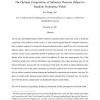Free Online Productivity Tools
i2Speak
i2Symbol
i2OCR
iTex2Img
iWeb2Print
iWeb2Shot
i2Type
iPdf2Split
iPdf2Merge
i2Bopomofo
i2Arabic
i2Style
i2Image
i2PDF
iLatex2Rtf
Sci2ools
MSOM
2010
2010
The Optimal Composition of Influenza Vaccines Subject to Random Production Yields
The Vaccine and Related Biologic Products Advisory Committee meets at least once a year to decide the composition of the influenza vaccine in the U.S. Past evidence suggests that the Committee could use a more systematic approach to incorporate observed information and to quantify the risks associated with different options. There are two key tradeoffs involved in this decision. One, if the Committee decides to retain the current vaccine composition instead of updating to a new one, there is lower uncertainty in production yields, but the current vaccine could be less effective if a new virus strain spreads. Two, if the Committee decides early with less information, then manufacturers have more production time but the reduced information increases the risk of choosing a wrong strain. We derive an optimal dynamic policy for this decision. Due to the greater uncertainty in production yields of new vaccines, the optimal thresholds are neither symmetric between retaining and updating the ...
| Added | 20 May 2011 |
| Updated | 20 May 2011 |
| Type | Journal |
| Year | 2010 |
| Where | MSOM |
| Authors | Soo-Haeng Cho |
Comments (0)

